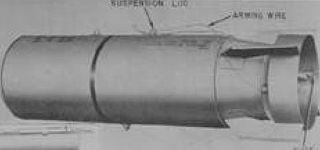Related Research Articles
The United States biological weapons program officially began in spring 1943 on orders from U.S. President Franklin Roosevelt. Research continued following World War II as the U.S. built up a large stockpile of biological agents and weapons. Over the course of its 27-year history, the program weaponized and stockpiled the following seven bio-agents :

The M33 cluster bomb, also known as the (M33) Brucella cluster bomb, was a U.S. biological cluster bomb developed in the early 1950s and deployed in 1952. It was the first standardized biological weapon in the U.S. arsenal.

The M114 bomb was a four-pound U.S. anti-personnel bomb and biological cluster bomb sub-munition. The M114 was used in the M33 cluster bomb.
The M115 anti-crop bomb, also known as the feather bomb or the E73 bomb, was a U.S. biological cluster bomb designed to deliver wheat stem rust.

The Flettner rotor bomblet was a U.S. biological sub-munition that was never mass-produced. Based on the vertical Flettner rotor which takes advantage of the Magnus effect, a force acting on a spinning body in a moving airstream, it was developed toward the end of the U.S. biological weapons program in the 1960s.
The E77 balloon bomb was a U.S. anti-crop biological munition based on the design of Japanese Fu-Go balloon bomb. The E77 used feathers as a vector to disseminate anti-crop agents from a hydrogen-filled balloon and was first developed in 1950.

The M34 cluster bomb was the first mass-produced United States Army weapon meant to deliver the chemical agent sarin (GB). A large stockpile of M34s was destroyed between 1973 and 1976.

The M43 BZ cluster bomb, or simply M43 cluster bomb, was a U.S. chemical cluster bomb intended to deliver the incapacitating agent known as BZ. The weapon was produced in the early 1960s and all stocks of U.S. BZ were destroyed by 1989.

The M44 generator cluster was an American chemical cluster bomb designed to deliver the incapacitating agent BZ. It was first mass-produced in 1962 and all stocks of the weapons were destroyed by 1989.
The E14 munition was a cardboard sub-munition developed by the United States biological weapons program as an anti-crop weapon. In a series of field tests in 1955, the E14 was loaded with fleas and air-dropped.
The E61 anthrax bomblet was an American biological sub-munition for the E133 cluster bomb. This anti-personnel weapon was developed in the early 1950s and carried 35 milliliters of anthrax spores or another pathogen.
The E23 munition was a cardboard sub-munition developed by the United States biological weapons program for use as an anti-crop weapon. The E23 underwent a conversion for use as a vector weapon and was briefly used in large-scale entomological warfare trial but technical issues forced it from the tests.
The M125 bomblet was a U.S. chemical sub-munition designed to deliver the nerve agent sarin. It was brought into service in 1954 with the M34 cluster bomb as part of the first U.S. air-delivered nerve agent weapon.

The MC-1 bomb was the first U.S. non-clustered air-dropped chemical munition. The 750-pound (340 kg) MC-1 was first produced in 1959 and carried the nerve agent sarin.
The E96 cluster bomb was an American anti-personnel biological cluster bomb developed in 1950.
The E48 particulate bomb was a U.S. biological sub-munition designed during the 1950s for use with the E96 cluster bomb.

The M134 bomblet was a U.S. chemical sub-munition designed for use in the Honest John rocket during the 1950s. The weapon was never mass-produced and was supplanted in 1964 by an improved design, the M139.
The Granite Peak Installation (GPI) — also known as Granite Peak Range — was a U.S. biological weapons testing facility located on 250 square miles (650 km2) of Dugway Proving Ground in Utah. The GPI was a sub-installation of Dugway but had its own facilities, including utilities. Established in 1943, GPI was deactivated with the end of World War II.
References
- 1 2 3 4 5 6 Whitby, Simon M. Biological Warfare Against Crops, (Google Books), Macmillan, 2002, pp. 167-69, ( ISBN 0333920856).
- 1 2 3 Wheelis, Mark, et al. Deadly Cultures: Biological Weapons Since 1945, (Google Books), Harvard University Press, 2006, p. 218, ( ISBN 0674016998).
- ↑ Zilinskas, Raymond A. Biological Warfare: Modern Offense and Defense, (Google Books), Lynne Rienner Publishers, Boulder, Colorado: 2000, p. 68, ( ISBN 1555877613).
- 1 2 Kirby, Reid. "Using the flea as weapon Archived 2007-06-11 at the Wayback Machine ", Army Chemical Review , July 2005, accessed December 28, 2008.